-
Categorized resources to help
you better understand self-injury.We have tried to make our site easier to navigate by dividing our resources up by topic and by audience. If you are interested in seeing everything we have developed, we invite you to peruse the top two categories “Information Briefs” and “Practical Matters” since all SIRR developed resources are listed in these two basic categories by topic
If you have an idea for a publication or other resource that is not here, we invite you to contact us with your recommendation.
All of our resources are free and available for public use and distribution, we just ask that you appropriately cite our research program as the source.
Parents, be sure to check out Healing Self-Injury, Dr. Whitlock’s new book written with her colleague, Dr. Lloyd Richardson. You can learn more about the book on our books and articles tab. or purchase the book from Oxford University Press. Information Briefs and Practical Matters:
-
Information briefs
-
Practical matters
- Understanding and using the stages of change to assess your own progress (for individuals who self-injure)
- Understanding and using the stages of change model (for parents and other adults) /Infographic
- Distraction techniques and alternative coping strategies / Spanish /Infographic
- Finding your voice: Talking about self-injury
- Therapy: What to expect
- Therapy: Myths and misconceptions / Spanish
- Reaching out for help: Talking about ongoing self-injury
- Dealing with power struggles
- Reaching out for help: Talking about ongoing self-injury
- Family policies: Safety concerns and contracts
- For parents: the importance of self-care
- Positive communication strategies
- Respectful curiosity
- Telling family and friends
- Wounds heal but scars remain: Responding when someone notices and asks about your past self-injury
- Bringing up self-injury with your clients
- Understanding and using the stages of change to assess your own progress (for individuals who self-injure)
-
Visual resources
Infographic: Self-Injury Basics (Download PDF)

Infographic: Stages of Changes, Parent Support (Download PDF)

Infographic: Emotion Regulation: What is it and how do we do it? (Download PDF)
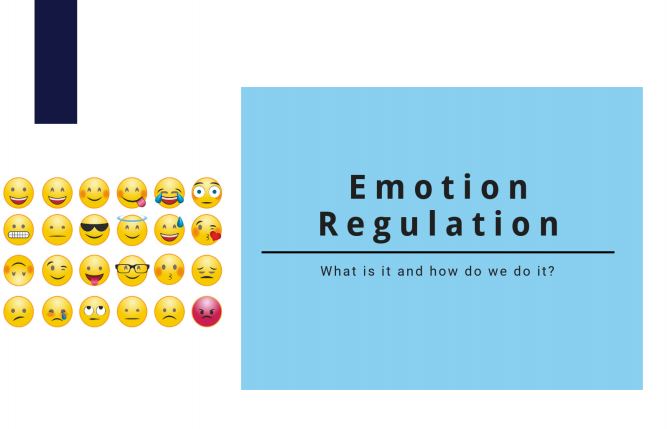
Infographic: What is the Link? The Relationship Between NSSI and Social Media (Download PDF)
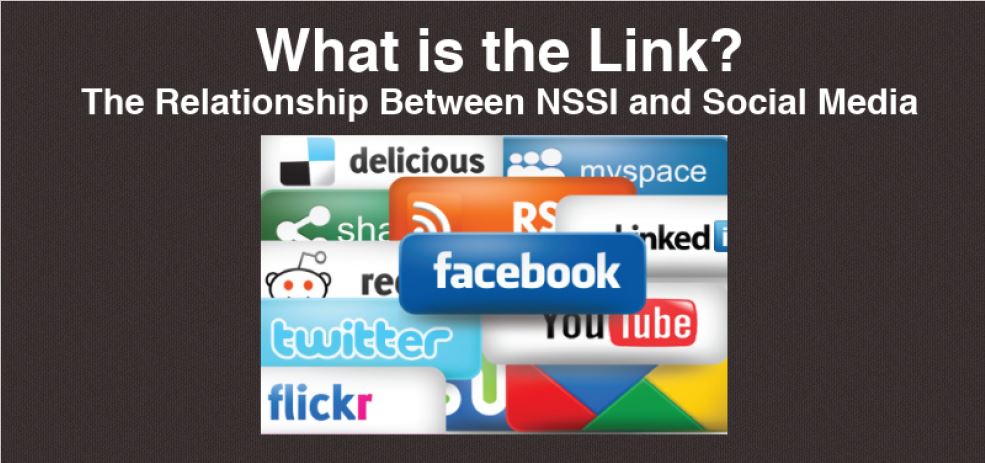
Infographic: Top 15 Misconceptions of Self-Injury (Download PDF )

Infographic: The Relationship Between NSSI and Suicide (Download PDF )
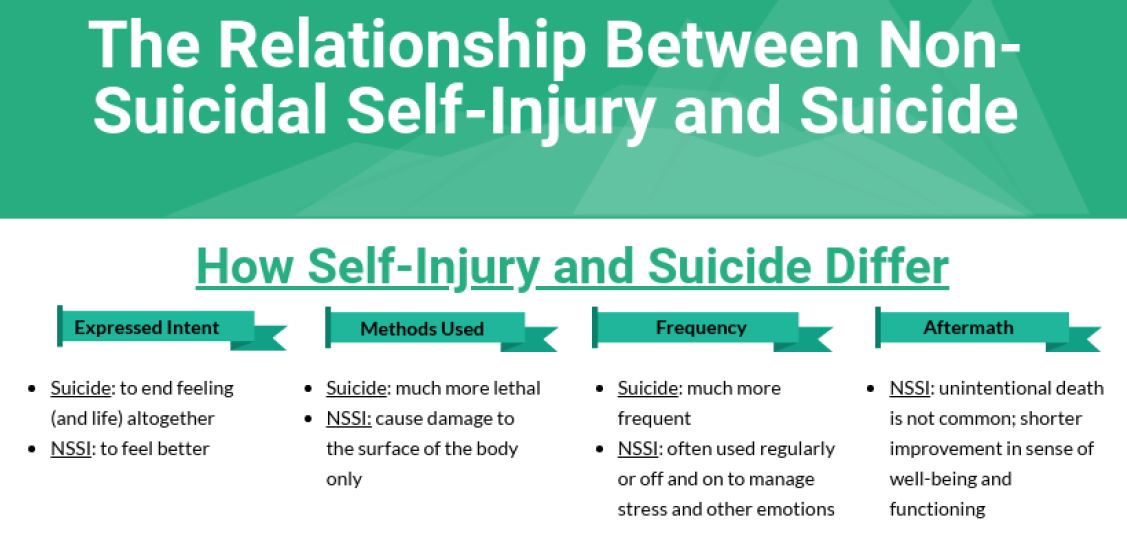
Infographic: Distraction Techniques and Alternative Coping Strategies (Download PDF)

Infographic: Helpful & Unhelpful Strategies for Parents (Download PDF)
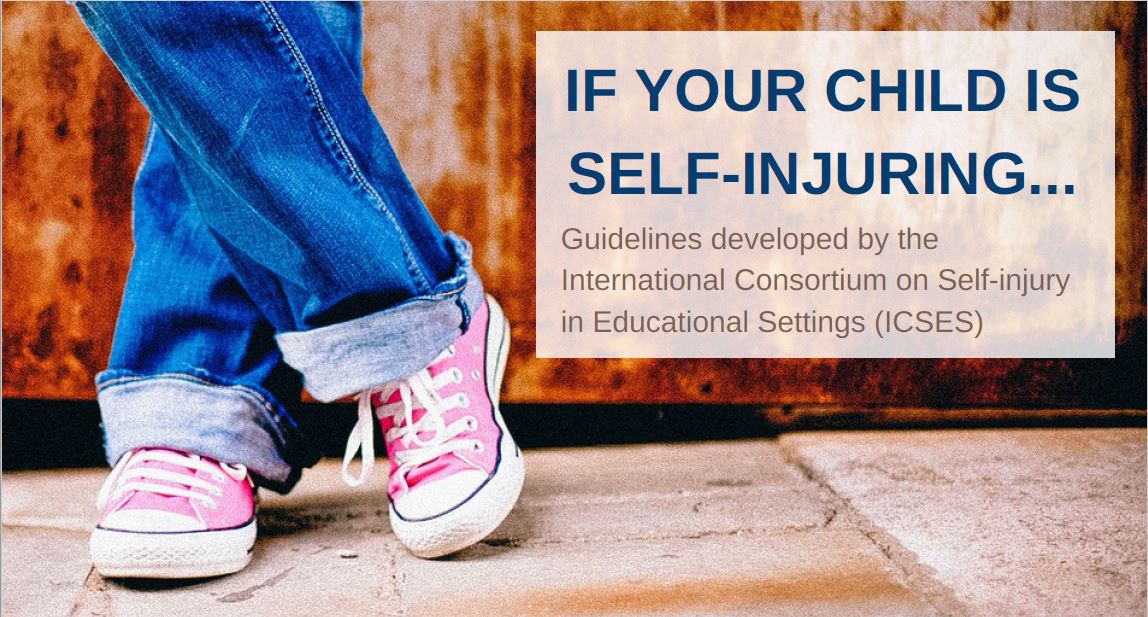
Infographic: NSSI School Protocol Process (“Download PDF”)

Infographic: Stress Management and Coping Strategies (Download PDF)

Infographic: How To Talk to Students About NSSI (Download PDF English / French)
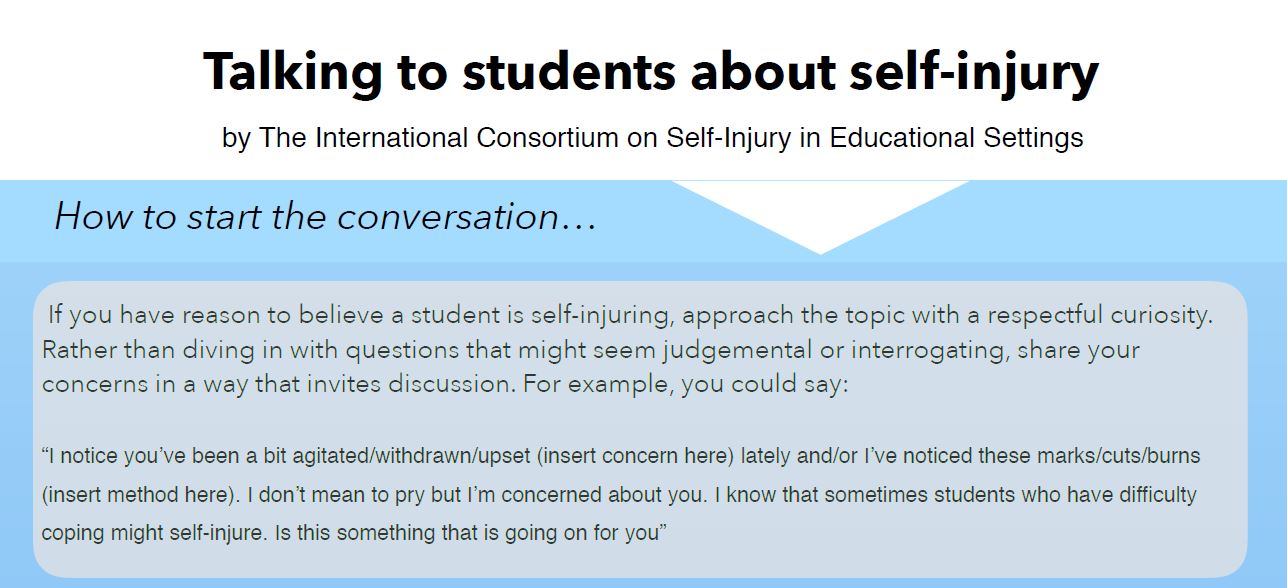
Infographic: How To Talk to Individuals About NSSI (Download PDF English / French)
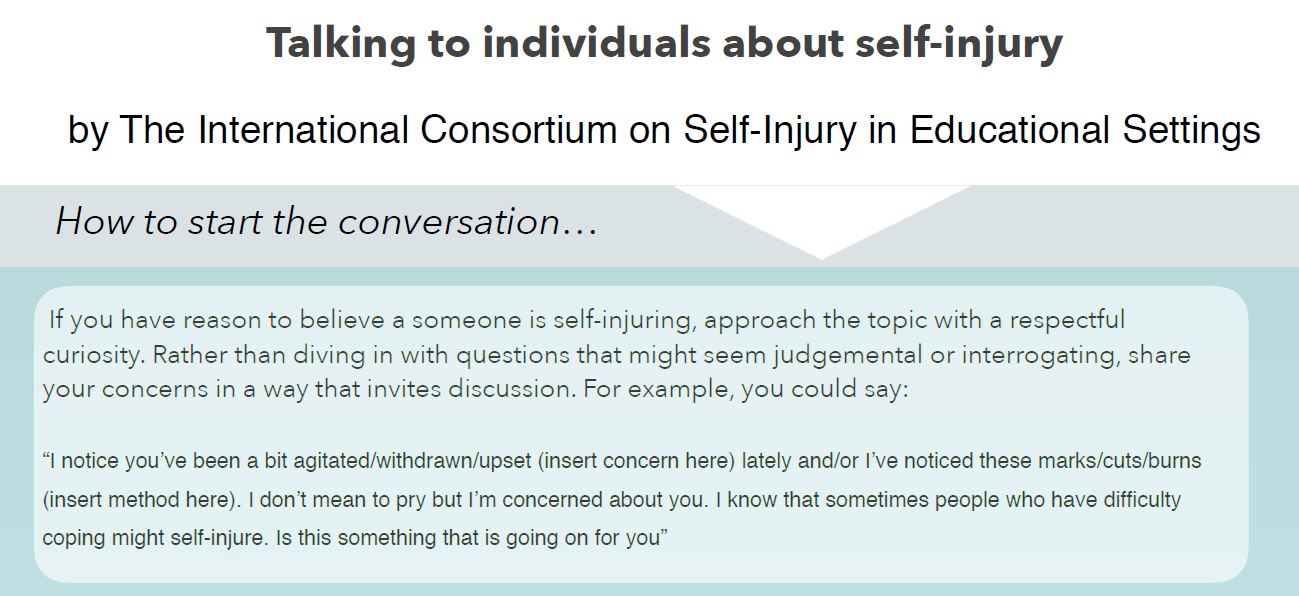
Infographic: Self-Injury and Help Seeking Behaviors (Download PDF)

Resources for:
-
People who self-injure
- What is self-injury
- 15 Misconceptions / English / French / Spanish
- Coping: Stress management strategies / English / French / German
- Distraction techniques and alternative coping strategies / English / Spanish
- Finding your voice: Talking about self-injury
- Wounds heal but scars remain: Responding when someone notices and asks about your past self-injury
- Recovering from self-injury
- Therapy: Myths and misconceptions / English / Spanish
- Therapy: What to expect
- Understanding and using the stages of change to assess your own progress (for individuals who self-injure)
- How does self-injury change feelings?
- Reaching out for help: Talking about ongoing self-injury
- What’s the relationship? Non-suicidal self-injury and eating disorders / English / Spanish
- The relationship between non-suicidal self-injury and suicide
- What role do emotions play in non-suicidal self-injury?
- What is emotion regulation and how do we do it?
- What is the link? The relationship between non-suicidal self-injury and social media
-
Parents & other caring adults
- Information for parents: What you need to know / English / French / German
- 15 Misconceptions / English / French / Spanish
- Recovering from self-injury
- Coping: Stress management strategies: English / French / German
- Self-injury in the media
- Therapy: Myths and misconceptions / English / Spanish
- Therapy: What to expect
- Dealing with power struggles
- Family policies: Safety concerns and contracts
- For parents: the importance of self-care
- Positive communication strategies.
- Respectful curiosity
- Understanding and using the stages of change model (for parents and other caring adults)
- How does self-injury change feelings?
- What’s the relationship? Non-suicidal self-injury and eating disorders
- The relationship between non-suicidal self-injury and suicide
- What role do emotions plan in non-suicidal self-injury?
- What is the link? The relationship between non-suicidal self-injury and social media
*Infographic: How To Talk to Students About NSSI English / French
*Infographic: How To Talk to Individuals About NSSI English / French -
Friends
-
Therapists / Clinicians
- What is self-injury
- 15 Misconceptions / English / French / Spanish
- Coping: Stress management strategies: English / French / German
- Distraction techniques and alternative coping strategies / English / Spanish
- Recovering from self-injury
- Understanding and using the stages of change to assess your own progress (for self-injurer’s)
- Bringing up self-injury with your clients
- What’s the relationship? Non-suicidal self-injury and eating disorders / English / Spanish
- The relationship between non-suicidal self-injury and suicide
- What role do emotions plan in non-suicidal self-injury?
- What is emotion regulation and how do we do it?
- Please see our resources for parents and other caring adults, schools, and peers for possible client resources.
- What is the link? The relationship between non-suicidal self-injury and social media
-
Youth serving professionals
- What is self-injury
- 15 Misconceptions / English / French / Spanish
- Coping: Stress management strategies: English / French / German
- Distraction techniques and alternative coping strategies / Engligh / Spanish
- Non-suicidal self-injury in schools: Developing a school protocol
- How does self-injury change feelings?
- The relationship between non-suicidal self-injury and suicide
- What is emotion regulation and how do we do it?
- Please see our resources for parents and other caring adults, schools, and peers for possible client resources.
- What is the link? The relationship between non-suicidal self-injury and social media
Resources about:
-
Self-injury basics, myths & facts
- What is self-injury
- 15 Misconceptions / English / French / Spanish
- How does self-injury change feelings?
- What role do emotions plan in non-suicidal self-injury?
- What’s the relationship? Non-suicidal self-injury and eating disorders / English / Spanish
- The relationship between non-suicidal self-injury and suicide
- The relationship between NSSI and LGBTQ+ identities
- Understanding the neurobiology of non-suicidal self-injury
-
Coping
-
Detection, intervention, and treatment
- Therapy: Myths and misconceptions / English / Spanish
- Therapy: What to expect
- Understanding and using the stages of change to assess your own progress (for individuals who self-injure)
- Understanding and using the stages of change model (for parents and other caring adults)
- What role do emotions plan in non-suicidal self-injury?
- What’s the relationship? Non-suicidal self-injury and eating disorders / English / Spanish
- The relationship between non-suicidal self-injury and suicide
- Bringing up self-injury with your clients
*Infographic: How To Talk to Students About NSSI English / French
*Infographic: How To Talk to Individuals About NSSI English / French -
Media
-
Schools
- Non-suicidal self-injury in schools: Developing a school protocol / Infographic
- 15 Misconceptions / English / French / Spanish
- Self-injury in the media
- Information for parents: What you need to know about self-injury
- Respectful curiosity
- Bringing up self-injury with your clients
- How does self-injury change feelings?
- The relationship between non-suicidal self-injury and suicide
- Connectedness and suicide prevention in college settings: Directions and implications for practice.
- What is the link? The relationship between non-suicidal self-injury and social media
- Infographic: How To Talk to Students About NSSI English / French
-
Recovery
- Recovering from self-injury
- Understanding and using the stages of change model to assess your own progress (for individuals who self-injure)
- Coping: Stress management strategies / English / French / German
- Distraction techniques and alternative coping strategies / English / Spanish
- Therapy: Myths and misconceptions / English / Spanish
- Therapy: What to expect
- Finding your voice: Talking about self-injury
- Wounds heal but scars remain: Responding when someone notices and asks about your past self-injury
-
Disclosure
-
Parenting strategies & self-injury
- Information for parents: What you need to know / English / French / German
- Dealing with power struggles
- Family policies: Safety concerns and contracts
- For parents: the importance of self-care
- Positive communication strategies.
- Respectful curiosity
- Telling family and friends
- Understanding and using the stages of change model
- How does self-injury change feelings?
- What is the link? The relationship between non-suicidal self-injury and social media
-
-
TV, documentaries, podcasts and talk shows
- Screens and Children (2023, October) Depression: Youth Mental health and Digital Media. Ask the Expert series.
- Fink, M & Fink, S. WBGO NPR. (2023, May 10). The Paradox of Self-Injury. Conversations with Sydney (Ep. 4)
- CXMH. (2023, March 27). Self-Harm: Compassionate Understanding & Healing (feat. Dr. Jans Whitlock)
- Personal Resilience Science Labs (2023, February). Finding the Strength to Live: Bounding Back #15).
- JED Voices Video (2022, February 2). ALONZO on Mental Health and Resilience
- New Day (2022; February 23). How can I handle this constant anxiety? Lemonada media.
- Jong, M. (January, 2022). Are the kids alright?. Retrieved from:
- CBS Local news (2021). The Sit-Down: Alexandra Shiva & Dr. Janis Whitlock.
- Last Day. (2021). Why Do People Cut Themselves? Lemonada Media
- Last Day. (2021) The Great Darkness. Lemonada Media
- Campus Outreach Services (2021). Social Media: Courtney Knowles and Dr. Janis Whitlock with COS
- Friends of the Children: Seattle (2021) Closing the Mental Health Gap: How COVID-19 Has Impacted Our Youth
- TheJennaAndrews. (2021). The Green Room S1,Ep11 – Tegan & Sara, Alex Hope, and Janis Whitlock * TheJennaAndrews (2021). The Green Room – Upsahl and Janis Whitlock. * Moody, M. (2020). Understanding our emotional regulation (and self-injury in adolescence) | research Scientist. Dr. Whitlock. Elements of Being Podcast.
- The Psychology of Self-Injury (2020, December 31st). Parenting Youth Who Self-Injure, with Dr. Janis Whitlock
- Silverman, R. (Host). (2020, March 3) How to talk to kids about self-injury with Dr. Janis Whitlock (Ep. 132)[Audio podcast] episode. In How to talk to kids about anything. https://drrobynsilverman.com/how-to-talk-to-kids-about-self-injury-with-dr-janis-whitlock/
- Doing Translational Research, “Cultivating ‘Broader, Better Human Beings’” (January 22, 2018)
- WCNY Cycle of Health, “Self Harming, Living With HIV, How to be Happy” (July 30, 2015)
- Zinn, M (Director). 2014. Self-inflicted [DVD]. United States (Available from Human Relations Media). Access summary at http://www.monicazinn.com/self-inflicted.html
- inSocialWork Podcast Series (University at Buffalo, School of Social Work) “Episode 95 – Dr. Janis Whitlock: The Cutting Edge: Self-Injurious Behavior in Adolescents and Young Adults” (April 30, 2012)
- “Your Time with Kim Iverson” (January 27, 2010)
- Bare, Ili (Director). 2010. The silent epidemic [DVD]. Australia. (Available from: Beyond production; Northern Pictures). Access summary at: http://www.selfinjury.bctr.cornell.edu/resources.html#tab6
- Good Morning America, “Message Boards Could Be Encouraging Cutting” (May 1, 2006)
- Children’s Health on Ideastream (Cleaveland PBS radio & TV): “The Paradox of Cutting”.
- The Early Show: “Teen Shares Self-Injury Secret“ (June 5, 2006)
- WHYY Voices in the Family, “Price of Privilege” (July 24, 2006)
- 1590 The Connection, “Self-Injury in adolescents” (June 14, 2006)
Print Media, Blogs & Commentaries
- MovieGuide (March 30, 2023) Self-harm post jump 500% on Twitter. Movieguide. https://www.movieguide.org/news-articles/self-harm-posts-jump-500-percent-on-twitter.html.
- Hana Shaji, A.and Watson, M. The tough truth of trauma dumping on social media. The Arlington Shorthorn. https://www.theshorthorn.com/life_and_entertainment/the-tough-truth-of-trauma-dumping-on-social-media/article_54766b1c-9a84-11ec-bb72-6bbfc78de7c6.htm.
- Thompson, D. U.S. Teens Were Already in Mental Health Crisis Before Pandemic Hit. HealthDay. https://www.healthday.com/health-news/public-health/1-24-teens-were-already-facing-mental-health-crisis-before-pandemic-struck-2656434086.html.
- Krantz, L. (2020, October 5). Isolated college first-years look to Instagram to make friends. The Boston Globe. https://www.bostonglobe.com/2020/10/04/metro/isolated-college-first-years-look-instagram-make-friends/
- Anderson, G. (2020, September 11). Mental health needs rise with pandemic. Inside Higher Ed. https://www.insidehighered.com/news/2020/09/11/students-great-need-mental-health-support-during-pandemic
- Ruiz, R. (2020, September 17). 4 ways that young people are thriving despite the trauma of 2020. Mashable. https://mashable.com/article/teen-mental-health-covid/
- Anderson, G. (11 September, 2020). Mental Health Needs Rise With Pandemic. Inside Higher Ed. Retrieved from: https://www.insidehighered.com/news/2020/09/11/students-great-need-mental-health-support-during-pandemic
- Chirichella, C. (2020, August 20). Scarred by My Own Hands. The New York Times. https://www.nytimes.com/2020/08/20/well/live/self-harm-scratching-skin-bullying.html
- Ome, M. (6, August, 2020). Dear diary: This is my life in quarantine. Atlantic Monthly. Retrieved from: https://www.theatlantic.com/family/archive/2020/08/why-are-people-keeping-coronavirus-diaries/614977/
- Strauss, E. (14 November, 2019). Why we should stop calling it ‘screen time’ to our kids. CNN Health. Retrieved from https://www.cnn.com
- Carey, B. (11 November, 2019). Getting a handle on self-harm. The New York Times. Retrieved from https://www.nytimes.com
- Fiedler, C.M. (2019, 23 September). The link between academic success & screen time is layered, study says. Romper. Retrieved from https://www.romper.com/
- Thompson, D. (2019, 23 September). Screen time probably won’t hurt your kid’s grades. WebMD. Retrieved from https://www.webmd.com/
- Whitlock, J. (August 2019). As a researcher, here’s what I want parents to know about self-harm. The Mighty. Retrieved from https://themighty.com/2019/08/janis-whitlock-elizabeth-lloyd-richardson-self-harm-book-parents/
- Lefkowitz, M. (2019, August 21). Kids can test drive social media safely with new simulations. Cornell Chronicle. Retrieved from https://news.cornell.edu.
- Whitlock, J. (13 August, 2019). Cornell expert: Social media is affecting us in complex ways we don’t understand (Commentary). Syracuse.com. Retrieved from https://www.syracuse.com/opinion/2019/08/cornell-expert-social-media-is-affecting-us-in-complex-ways-we-dont-understand-commentary.html
- Pattani, Aneri. “Self-harming affects nearly 1 in 5 teens. But we hardly talk about it.” (March 26, 2019)
- Fabian, Renée. “Why Aren’t There More Resources For Adult Self-Injurers?” (March 21, 2017)
- PBS News Hour, “Can Instagram’s new tool really help users who self-harm?” (January 16, 2017)
- TIME Magazine “Teen Depression and Anxiety: Why the Kids Are Not Alright” (October 27, 2016)
- The Ringer, “Tumblr’s Depression Connection” (October 24, 2016)
- Chicago Tribune, “Those who self-injure actually want to feel less pain” (October 9, 2015)
- Vice News, “How Tattoos Can Ease the Emotional Pain of Self-Harm Scars” (S. Solomon, August 21, 2015)
- AEON, “Why self-harm? Cutting brings relief because emotion and pain criss-cross in the brain. Can we untangle the circuits and stop self-harm?” (C. Arnold, October 13, 2014)
- NBC News, Generation stress? How anxiety rules the secret life of teens (A. Pawlowski, September 17, 2014)
- Research Media, Silent epidemic (International Innovation, April 2014)
- Fox News, Cutting and self-harm: Is your kid doing it? (Julie Revelant, March 16, 2014)
- Reuters, Self-injury information available online, but rarely accurate. (Andrew M. Seaman, March 27, 2014)
- New York Times, How a college roommate can affect your child (Perri Klass, M.D., February, 24, 2014)
- Wayne Post, Scars of a different battle: Why do people self-harm? (Melody Burri, February 16, 2014)
- Psychology Today, Speaking the soul: Why kids cut and what we can do about it. (Janis Whitlock, February, 2014)
- Reuters, Online forums a ‘mixed bag’ for depressed youth. (Genevra Pittman, October 30, 2013)
- The Boston Globe, Facing the puzzling urge to self injure (Kay Lazar, March 11, 2013)
- The Florida Sun Sentinel, Increase in self-embedding (Shari Roan, January 7, 2009)
- The New York Times, The growing wave of teenage self-injury (Jane Brody, May 6, 2008)
- Chronicle of Higher Education, Are we facing an epidemic of self-injury? (Joan Brumberg, December 6, 2006)
- Associated Press, 17 Pct. at 2 schools practice self-abuse (Lindsey Tanner, June 5, 2006). Note: This and related articles were picked up by most major news papers in the US including but not limited to NYT, Chicago Tribune, San Francisco Chronicle, Washington Post, Detroit News. Cornell Press Relations estimates a total circulation of 29,512,189.00
- Inside Higher Ed, Self-injury epidemic (Rob Capriccioso, June 5, 2006)
- Reuters, High rate of self-harm seen among college students (Anne Harding, June 8, 2006)
- CBS News, Pros and cons of kids’ web use: Studies show mix of potential benefits, risks when kids go online (Miranda Hitti, May 1, 2006)
- Kansas City Star, Internet sites encourage self-injuring (Karen Uhlenhuth, May 1, 2006)
- MTV News, Dangerous relief: Teens increasingly turn to self-abuse to cope with stress (Shana Leonard, June 13, 2006)
-
Interviews, Documentary Films, & More
Watch these interviews to hear more from actual CRPSIR interview participants:
Why Self-Injure?
What I’m Taking Away From This Expereince
Responding – Finding Out
Responding – First Conversations
Responding – Advice
Recovery
The Silent Epidemic: This documentary delves into the scientific and socially misunderstood world of self-harm, shedding light on groundbreaking scientific research and offering hope.
Part 1
Part 2
Part 3
Part 4
CUT: Teens and Self Injury. Watch an interview with the filmmaker Wendy Schneider below. You can find the full hour long CUT film here
Listen to Dr. Janis Whitlock’s talk: “Lessons Learned from Research on Self-injury and Families.”
-
Resources on treatment:
- TheRavive, is a network of licensed and professional counsellors, therapists, and psychologists who uphold clear, compassionate values in therapy. Theravive’s purpose is to connect you to the right professional, giving you a better direction, new goals, and a clearer understanding of how to get there.
- The Bridge of Central Massachusetts provides compassionate, evidence-based human services for those with mental health challenges, developmental and intellectual disabilities, autism, acquired brain injury, substance use disorders, homelessness and other complex challenges.
- Behavioral Tech LLC trains mental health care providers and treatment teams who work with complex populations to use compassionate, scientifically valid treatments and to implement and evaluate these treatments in their practice setting. They provide information and resources about Dialectical Behavioral Therapy (DBT) for providers, clients, parents, researchers, and more, including a therapist directory. and training in DBT.
- Four Winds Hospitals have two locations in Katonah, NY and Saratoga NY. They provide inpatient and outpatient mental health treatment services for children, adolescents and adults, and are leading specialized providers of inpatient psychiatric treatment for children, adolescents and adults in the Northeast.
- SAFE Alternatives® (Self-Abuse Finally Ends) (1-800-366-8288) is a nationally recognized treatment approach, professional network and educational resource base, which is committed to helping achieve an end to self-injurious behavior. S.A.F.E. Focus Group is a self injury support group based off of the S.A.F.E. Alternatives Program. Also, check out S.A.F.E.‘s informative Youtube videos!
Other helpful websites:
- The American Foundation for Suicide Prevention has created of list of up to date mental health resources for BIPOC and those in minority communities.
- National Suicide Prevention Lifeline: If you feel you are in a crisis, whether or not you are thinking about killing yourself, please call the Lifeline. People have called for help with substance abuse, economic worries, relationship and family problems, sexual orientation, illness, getting over abuse, depression, mental and physical illness, and even loneliness. By calling 1-800-273-TALK (8255) you’ll be connected to a skilled, trained counselor at a crisis center in your area, anytime 24/7. There is also the feature to chat with someone from 2pm until 2 am, daily!
- SiOS Self-injury Outreach & Support: As part of a collaboration between the University of Guelph and McGill University, we are a non-profit outreach initiative providing information and resources about self-injury to those who self-injure, those who have recovered, and those who want to help.
- The Self-Injury Support Library compiles a vast range of resources designed for those who self-injure, as well as family, friends, and professionals.
- The National Self-Harm Network (UK)
- Orygen has released several guides including ‘Coping with Self-Harm’ – a guide for parents and carers of young people engaging in self-harm, which is an adapted version of the resource developed by Keith Hawton and colleagues at The University of Oxford (UK)
- The Mighty’s Guide to Understanding Self-Harm, which was developed with help from expert knowledge from professionals, and surveys from nearly 3,000 people with a history of self-harm to get their experiences.(Overview |For Young People |For Adults |For Parents and Loved Ones |Resources)
- The University of Nevada (Reno) has put together this article on suicide prevention and awareness. The article includes information on what suicidal behavior is, who vulnerable populations are, how suicide intersects with other mental health issues, and how to view suicide through a public health lens.
- The Recovery Village’s self-harm fact sheet includes information on forms and signs of self-injury, prevention of self-injury, and how to help a loved one, along with other valuable information. Be sure to download their infographic as well!
- The Crisis Text Line serves young people in any type of crisis, providing them access to free, 24/7, emotional support and information they need via the medium they already use and trust: TEXT. To utilize this resource or read more click here.
- *Effective child therapy. is an excellent resource for information on evidence-based treatments for children and adolescents struggling with mental health.
- Loveislouder.com provides support to those feeling mistreated or alone. The project is designed to engage individuals in expressing their feelings and promotes positive thinking, words, and behaviors in communities. Read more about the organization here.
- emotionsanonymous.org “The EA membership is composed of people who come together in weekly meetings for the purpose of working toward recovery from emotional difficulties. EA members are from many walks of life and are of diverse ages, economic status, social and educational backgrounds. The only requirement for membership is a desire to become well emotionally.”
- ReachOut.com: This organization provides online resources for youth struggling with mental health. The site gives users the opportunity to build peer support networks through forums and presents extensive information through fact sheets, blogs, and other online tools. Find ReachOut.com’s resources specifically on self injury here.
- Strengthofus.org is an online community providing resources on positive thinking to those struggling with mental health. Users can read blogs, participate in forums, or read and listen to the great content featured on the website.
- Critical Mental Health Resources for College Students: This website is meant to provide college students and young people with quality information on maintaining good mental health and identifying mental health issues.
- Your Life Counts: “Helping Youth & Families To Nurture, Protect & Sustain Their Will To Live…”
- The American Academy of Child and Adolescent Psychiatry is aimed at helping parents and families in understanding emotional, developmental, behavioral and mental disorders affecting children and
- Inspiring Connections is a Canadian organization that provides training and other resource materials to organizations, professionals and laypersons who want to learn more about self-injury and working with people who self-injure.
- Mental Health America has an on-line factsheet about self-injury available here and a breakdown of helpful vs. harmful emotion regulation strategies here.
- To Write Love on Her Arms is a non-profit movement dedicated to presenting hope and finding help for people struggling with depression, addiction, self-injury and suicide. TWLOHA exists to encourage, inform, inspire and also to invest directly into treatment and recovery.
- The Recover website offers help for anyone who wants a solid solution for their suicide issues. Take a suicidal prevention checklist self-test, learn about nutrition, neurotransmitter imbalances, prescription medication, treatment, and more.
- This resource from Everdayhealth.com provides information on why many people with bipolar disorder, especially younger women, injure themselves by cutting or burning. Learn why people self-injure, and how loved ones can help.
-
Addiction Recovery Resources
- First City Recovery Center provides parents and teens with information on identifying and seeking treatment for a variety of substance use disorders and other mental health concerns facing teenagers today.
- Blue Crest Recovery Center sheds a light on how problematic social media use impacts youth mental health and substance use disorders.
Adolescent Mental Health Resources
- 45 Tools and Resources for Student Mental Health is a list of digital resources and mobile apps designed to assist with anxiety and other mental health concerns teenagers face daily.
- “77 Public Health Resources for Youth Mental Health“https://www.publichealthdegrees.org/resources/public-health-resources-youth-mental-health/ provides a variety of mental health resources and programs for a variety of ages.
-
Healing Self-injury: A Compassionate Guide for Parents and Other Loved Ones 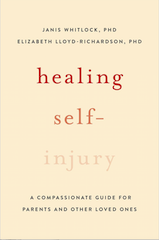
by Dr. Janis Whitlock and Dr. Elizabeth Lloyd-Richardson “offers strategies for identifying and alleviating sources of distress in children’s lives, improving family communication (particularly around emotions), and seeking professional help. Importantly, it also provides compassionate advice to parents with personal challenges of their own, explaining how these can impact the entire family. The book will help parents partner with their children to identify, build, and use skills that will assist them in recovering from self-injury. Vivid anecdotes drawn from the authors’ extensive in-depth interviews with real families in recovery from self-injury put a human face on what for many families is a distressing and often isolating experience.”You can purchase Healing Self-Injury from Oxford University Press, or anywhere books are sold
Oxford Handbook on Non-Suicidal Self-Injury 
The 2024 Oxford Handbook on Non-Suicidal Self-Injury provides a comprehensive and up-to-date overview of the current research, theory, and clinical approaches to understanding and treating non-suicidal self-injury (NSSI). This authoritative volume brings together leading experts in the field to explore the etiology, assessment, and intervention strategies for NSSI across diverse populations and settings. The handbook covers a wide range of topics, including neurobiological mechanisms, cultural considerations, and emerging treatments, offering valuable insights for researchers, clinicians, and policymakers alike. As a co-editor of this important work, I am proud to contribute to advancing our knowledge and improving care for individuals struggling with NSSI.
You can purchase Oxford Handbook on Non-Suicidal Self-Injury from Oxford University Press, or anywhere books are sold.
-
CRPSIR tools and assessments:
- NSSI-AT (Brief Version / Full Version / Brief version Thai Translation ): The NSSI-AT and the B-NSSI-AT are the full and brief versions of an assessment tool created by Cornell Research Program on Self-Injury and Recovery. The use of this tool is described in more detail here: (Validity and reliability of the non-suicidal self-injury assessment test, NSSI-AT) and can be used to assess primary NSSI characteristics, such as form, frequency, and function, as well as secondary characteristics (such as habituation, context in which NSSI is practiced, and perceived life interference, treatment and impact). This assessment is primarily used in research, but may also be useful in service settings.
- NSSI TTM: The NSSI-TTM was developed to assess Decisional Balance, Processes of Change, and Self-Efficacy related to changing self-injury behaviors. The validity and use of this tool are described in more detail here.
- School Protocol Guidelines: The SIRR school protocol for NSSI is intended for individuals working in school settings. This protocol provides a model from which schools can draw to develop tailored protocols to fit their unique settings.
- Severity Assessment: This tool is designed to assess NSSI severity. This can be used in primary service settings (e.g. Clinical, school, etc.) Characteristics of high, moderate and low severity classes are included along with implications for intervention.
- Helpful questions to assess sharing about self-injury practices online . This document is adapted from Whitlock, Lader, & Conterio, 2007, and includes helpful questions for clinicians to use when assessing the extent of a client’s online sharing habits about self-injury.




